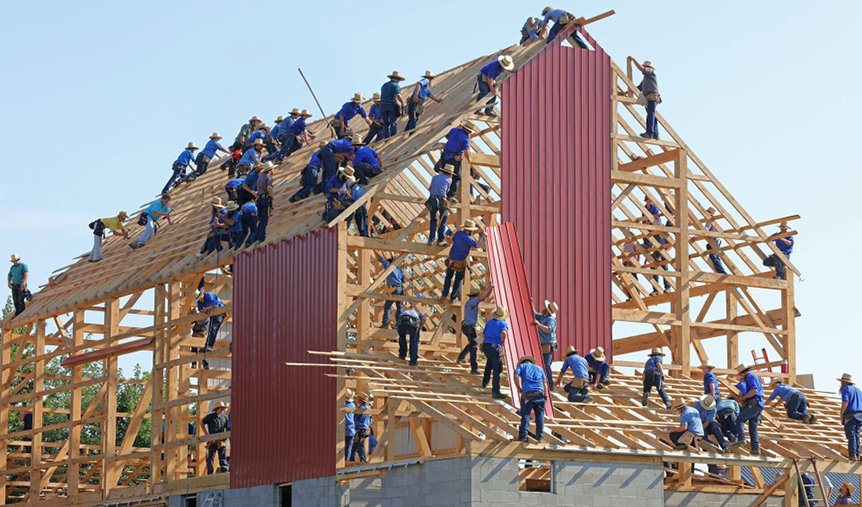The time spent by managers and employees in collaborative activities has increased by 50% or more in the past two decades (Cross et al., 2016). But this doesn’t mean employees know how to work together well or that leaders know how to build high-performing teams. In this post we will explore four common myths associated with teamwork.
Myth #1: Teamwork can overcome talent gaps
Technical (task) competence matters. For a team to be effective, team members need to be able to do their job, not just work together effectively (read more about effective collaboration here). Research indicates that it is difficult, if not impossible, to overcome a lack of talent through teamwork (Tannenbaum & Salas, 2020b).
Myth #2: Adding stars boosts team performance
Towards the end of the 1990s there were too few workers to replace retiring baby boomers (Keller, 2017). This led America’s largest and most prestigious consultancy firm, McKinsey, to declare a “War for Talent” and recommend their clients focus on recruiting and retaining the “best and brightest” (Satell & Windschitl, 2021). As companies began to follow this advice, however, dark unintended consequences emerged.
For example, at Enron, then the seventh largest company in the US, star performers were “rewarded inordinately, and promoted without regard for seniority or experience” (Gladwell, 2002). Individuals began to undermine colleagues, crushing teamwork in the process. Enron was charged with corporate fraud and collapsed taking one of the big five audit companies, Arthur Andersen, with it (Curwen, 2021). The point here is that having a ‘star’ or ‘talent’ mindset can seriously harm teamwork.
Scott Tannenbaum and Eduardo Salas, authors of Teams That Work: Seven Drivers of Team Effectiveness (2020a), further explain, “The relationship between talent, teamwork, and performance is actually a bit complex. For example, research shows that simply adding stars won’t always boost team performance. And you shouldn’t assume that individual excellence is enough unless you are working on tasks that require no coordination” (Tannenbaum & Salas, 2020b). Just because top performers excel in task competence doesn’t mean they possess teamwork skills. So, adding stars may boost team performance, but it’s not a given.
Myth #3: Conflict is bad for teams
“When the majority of a team’s disagreements are interpersonal in nature, performance tends to decline. But if most of their disagreements are task or work related, then the way they handle those conflicts determines whether performance improves or declines”, says Scott Tannenbaum (Duncan, 2020).
Where interpersonal relationships are not strained, a little discord can actually be beneficial to team performance, particularly when it involves team members speaking up about errors and concerns (Salas et al., 2015; Shaw et al., 2011). Without conflict, teams are at risk of a type of cognitive bias called groupthink in which consensus overrides the best idea (The Decision Lab, n.d.).
The research on team performance shows that established teams outperform newly formed teams (Coutu, 2009). But there is a danger of groups that have been together for some time becoming homogeneous – a death knell for creativity and learning. Pioneering team researcher J. Richard Hackman says, “Every team needs a deviant… Deviants are the ones who stand back and say, “Well, wait a minute, why are we even doing this at all? What if we looked at the thing backwards or turned it inside out?”… In our research…It turned out that the teams with deviants outperformed teams without them. In many cases, deviant thinking is a source of great innovation” (Coutu, 2009).
Myth #4: Team performance is linked to the intelligence of individual team members
In a study published in the esteemed journal Science, researchers found that team performance was related to the group’s collective intelligence (Woolley et al., 2010). However, collective intelligence was NOT linked to either the average or maximum intelligence of individual team members, but to “the equality in distribution of conversational turn-taking”. In other words, groups where a few people dominated the conversation were less effective than teams where each of the team members contributed about the same amount to discussions.
Learn more about How Leaders Help Their Teams Build Trust.
References:
- Coutu, D. (2009). Why Teams Don’t Work. Harvard Business Review. Retrieved 2 August 2022 from https://hbr.org/2009/05/why-teams-dont-work
- Cross, R., Rebele, R., & Grant, A. (2016). Collaborative Overload. Harvard Business Review. Retrieved 29 July 2022 from https://hbr.org/2016/01/collaborative-overload
- Curwen, L. (2021). The collapse of Enron and the dark side of business. BBC. Retrieved 5 August 2022 from https://www.bbc.com/news/business-58026162
- Duncan, R. D. (2020). With Learning And Communication, ‘More’ Is Not Necessarily ‘Better’. Forbes. Retrieved 31 July 2022 from https://www.forbes.com/sites/rodgerdeanduncan/2021/12/29/with-learning-and-communication-more-is-not-necessarily-better/
- Gladwell, M. (2002). The Talent Myth. The New Yorker. Retrieved 2 August 2022 from https://www.newyorker.com/magazine/2002/07/22/the-talent-myth
- Keller, S. (2017). Attracting and retaining the right talent. McKinsey. Retrieved 8 August 2022 from https://www.mckinsey.com/business-functions/people-and-organizational-performance/our-insights/attracting-and-retaining-the-right-talent
- Salas, E., Shuffler, M. L., Thayer, A. L., Bedwell, W. L., & Lazzara, E. H. (2015). Understanding and Improving Teamwork in Organizations: A Scientifically Based Practical Guide. Human Resource Management, 54(4), 599-622. https://doi.org/10.1002/hrm.21628
- Satell, G., & Windschitl, C. (2021). High-Performing Teams Start with a Culture of Shared Values. Harvard Business Review. Retrieved 6 August 2022 from https://hbr.org/2021/05/high-performing-teams-start-with-a-culture-of-shared-values
- Shaw, J. D., Zhu, J., Duffy, M. K., Scott, K. L., Shih, H. A., & Susanto, E. (2011). A contingency model of conflict and team effectiveness. J Appl Psychol, 96(2), 391-400. https://doi.org/10.1037/a0021340
- Tannenbaum, S., & Salas, E. (2020a). Teams That Work: The Seven Drivers of Team Effectiveness. Oxford University Press.
- Tannenbaum, S., & Salas, E. (2020b). Teamwork myths: what leaders need to know. Leader to Leader, 2020(98), 58-64. https://doi.org/10.1002/ltl.20518
- The Decision Lab. (n.d.). Groupthink. Retrieved 4 August 2022 from https://thedecisionlab.com/reference-guide/management/groupthink
- Woolley, A. W., Chabris, C. F., Pentland, A., Hashmi, N., & Malone, T. W. (2010). Evidence for a Collective Intelligence Factor in the Performance of Human Groups. Science, 330(6004), 686-688. https://doi.org/doi:10.1126/science.1193147



